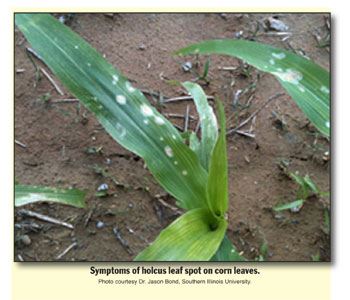Holcus Leaf Spot Of Corn In Southern Illinois
URBANA, ILL.
Holcus leaf spot, a somewhat
uncommonly observed
corn disease,
was diagnosed last week from
samples sent from a couple of
fields located in southern Illinois.
Holcus leaf spot is
caused by the bacterium
Pseudomonas syringae.
Symptoms appear as light-colored round spots
that can be observed
on the foliage of corn
and a few other
grassy weed hosts.
Some spots may have
edges with a “watersoaked”
appearance.
The symptoms can
be easily mistaken
for injury caused by
herbicide drift, and
the only way to get a
confident diagnosis
is to send samples to
a plant diagnostic lab
(such as the University
of Illinois Plant
Clinic).
Like most bacterial
diseases, holcus leaf
spot may be more severe
when wounds
are created on the
leaves by high winds
and/or hail. The
pathogen is most effective
at infecting
corn and causing
disease during
warm, wet weather
(75 to 85°F).

Most historical observations of holcus lead
spot have indicated that the disease will not
spread to non-infected leaves and that yield
losses generally are negligible. Because of the
low risk of yield loss, no management recommendations
are needed. Foliar fungicides are
not effective against holcus leaf spot, since the
disease is caused by a bacterium rather than a
fungus. Δ
DR. CARL A. BRADLEY: Associate Professor,
Crop Sciences, University of Illinois